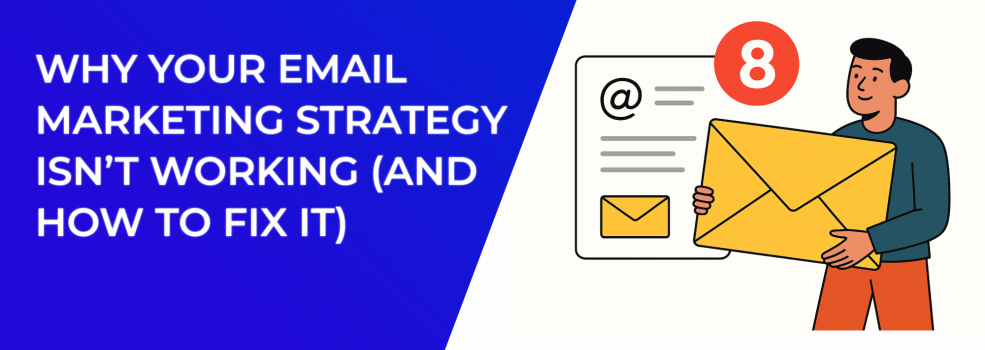Email can be the most profitable channel in your stack—or the most puzzling. When metrics start sliding — open rates dip, click-throughs stall, revenue flat-lines — it’s usually a sign of underlying issues that have gone unnoticed for too long. Below you’ll find seven common pitfalls and the practical fixes that breathe new life into even the most fatigued program.
1. Your Audience Has Outgrown Your List
A mailing list ages just like any asset. Dormant inboxes, spam traps, and irrelevant contacts creep in month after month and erode deliverability. If you can’t remember your last list-cleaning session, start there.
Action plan:
-
Schedule a quarterly hygiene pass to remove hard bounces and subscribers who haven’t opened in 90 days.
If you’re unsure how to zero-in on the right subscribers in the first place, our step-by-step guide to audience research breaks the process down, read it here. -
Collect new contacts with double opt-in and real-time validation tools, improving list quality from day one.
-
Segment new and existing names by behavior, purchase history, and lifecycle stage so each message lands with context.
A freshly pruned database yields instant lifts in email-marketing open rates and creates a truer picture of what content your audience actually wants.
2. Your Subject Lines Fail the “Thumb Test”
On a phone, you get about 40 characters to win attention. If the subject line reads like a filing label — “July Newsletter” — engagement dies before your copy even loads. The headline’s only job is to earn the first tap.
Action plan:
-
Run A/B tests for every send and track winners in a simple spreadsheet.
-
Lead with a clear benefit or curiosity hook.
-
Pair the subject line with compelling preview text to extend the story.
Test often — sometimes one word in the subject line makes all the difference.
Consistent testing turns guesswork into a playbook that steadily pushes up average open-rate benchmarks.
3. One-Size-Fits-All Messaging
A brand-new prospect, a VIP customer, and a lapsed buyer have wildly different motivations. Sending identical blasts ignores those realities and tanks relevance. Relevance is the currency of modern inboxes.
Action plan:
-
Build automated journeys — welcome flows, onboarding series, re-engagement prompts — mapped to each stage of the customer lifecycle.
-
Drop product blocks via dynamic content, matching each reader’s browsing history.
-
Add a preference center so subscribers control frequency and topic, giving you richer data for future targeting.
For a deeper dive into building hyper-relevant segments, check out Facebook Ad Targeting 101; the principles translate perfectly to email audiences
When messages speak to the moment a subscriber is in, click-through rates rebound quickly.
4. Ignoring the Mobile Majority
More than half of email interactions begin on a smartphone. Slow-loading images, multi-column layouts, or tiny buttons sabotage the experience before the copy gets a chance to persuade. If it’s hard to tap, it’s easy to ignore.
Action plan:
-
Design single-column, responsive templates; keep buttons at least 44 px square.
-
Compress images under 150 KB and add ALT text for accessibility (and inbox image blocking).
-
Preview every campaign in Gmail, iOS Mail, and Outlook before launching.
Designing for thumbs isn’t just an inbox issue; the same mobile-first rules power winning ads — see the best practices in our guide to mobile-friendly creatives.
A mobile-first mindset protects engagement signals that mailbox providers use to decide whether your next send lands in the inbox or the spam folder.
5. Chasing Vanity Metrics
Big list counts and “likes” look impressive, but they don’t pay the bills. Healthy programs measure what matters: deliverability, engagement, and revenue, always in that order.
This layered view helps you identify the weakest link first and invest where the payoff is highest.
Once you’re tracking revenue properly, layer in these lead-generation tactics to multiply pipeline growth.
6. Automation on Cruise Control
Even the best workflow stales out if it runs untouched for months. Product lines shift, offers expire, and user expectations evolve. Unchecked automations turn into ghosts of marketing past.
Action plan:
-
Audit every sequence at least twice a year. Update outdated content; retire the lowest performers.
-
Add behavior-based triggers — cart views, feature adoption, webinar attendance — for real-time relevance.
-
Reserve quarterly time for experimentation with new AI-powered optimization tools or creative content formats.
Need inspiration? Here’s a curated list of the best AI text and image generators you can plug into your workflow today.
Regular tune-ups keep the engine humming and safeguard engagement long after the initial build.
7. Forgetting the Human Behind the Inbox
With personalization tokens and data feeds flying everywhere, messaging can slip into robotic territory fast. Subscribers can sense automation, and they tune it out when it feels cold.
Real names and real voices connect more than perfect templates.
Action plan:
-
Write in a conversational tone, using contractions and vivid verbs.
-
Send from a real person, not a “no-reply” address, to invite genuine replies.
-
Close with a thoughtful question to spark dialogue and feed future segmentation insights.
Human warmth turns transactional notices into relationship-building touchpoints.
Pulling It All Together
Master the basics in this order — list health, subject-line experimentation, journey personalization, mobile-first design, results-focused metrics, automation maintenance, human storytelling — and your next campaign won’t just nudge the numbers; it will set a new performance baseline.
Quick-Start Checklist
Clean your database quarterly.
Test subject lines every send.
Automate journeys around lifecycle stages.
Optimize for mobile first.
Track layered KPIs, not vanity counts.
Pin these five lines where you plan your campaigns and you’ll anchor every tactic to sustainable growth.
Final Thought
When you treat email marketing as a dynamic conversation — supported by clean data, continuous testing, and genuine human voice — you move from unpredictable spikes to predictable success. Nail the fundamentals now, and you’ll create headroom to explore advanced tactics like predictive send times, AI-driven copy tweaks, and hyper-personalized content that keeps performance climbing quarter after quarter.

